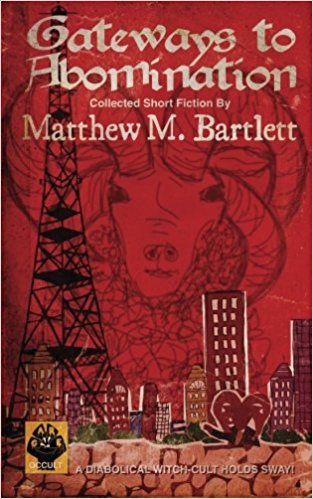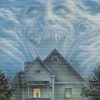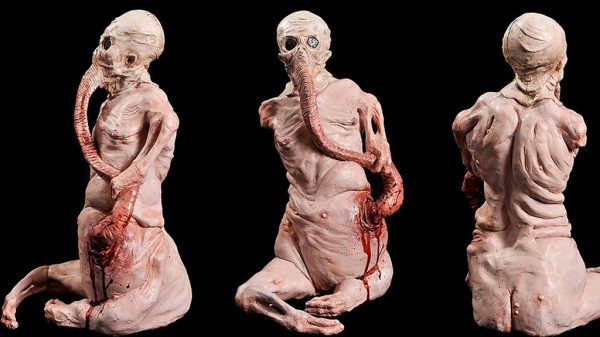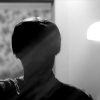No one really approaches horror the way Matthew M. Bartlett does. An overly simplistic way to summarize his work would be to say he writes short fiction about a witch cult that uses radio broadcasts to terrorize and infiltrate the small town of Leeds, Massachusetts. But that would only scratch the surface of the blood-soaked depths Bartlett mines. Over a handful of collections (from the self-published Dead Air and Gateways to Abomination to the recent Muzzleland Press-published Creeping Waves), his work feels less like stories than discovered artifacts; sometimes they turn out to be story-like in a traditional sense, but oftentimes he uses structure as a way to pull the rug out from under his readers. Stories presented in a third-person/omniscient-narrator mold turn out to actually be first-person radio dispatches (complete with station ID’s like “WXXT, the chuckle in the churchyard on a cloudless midnight” or “You’re listening to WXXT, where the knife meets the throat” or my personal favorite: “You’re listening to WXXT, home of the no-repeat workday. If you hear the same song played twice between 11:59 and midnight and you’re the sixth caller, good for you, Johnny Shit-Ears”). Many pieces feel fragmented and unfinished at first, only to be continued pages later under a new title. He even self-published a whole booklet of entries into the catalogue of a bookstore run by demons. It’s never quite clear what you are encountering until it is too late, much like what his characters experience.

Cover for Gateways To Abomination
Many pieces feature an unwitting schlub accidentally wandering into the frequency range of WXXT (the radio station run by a devil-worshipping witch cult) and suffering mightily. Others begin with a stark, modern office setting only to reveal how high up the corporate ladder the cult has invaded. A few even have investigators from the FCC trying to unearth the truth. Some pieces are stark news bulletins concerning townspeople of Leeds spiraling into insanity or reporting hearing the voices of their deceased loved ones urging them to copulate and murder. There are flying leeches, a gentleman with the head of a goat, infants being boiled into stew, and roads littered with vomit, limbs, and gore. Throughout all of his pieces is a voice that is confident and tinged with a sly humor; but that humor itself can be disarming. Right when you are laughing the hardest, Bartlett socks you with an image so grisly, or a character so pathetically out of options that you find yourself unbalanced and stunned.
I had the pleasure to email back and forth with him to probe deeper into the grotesque underbelly of his writing.

Illustration for re-print of Dead Air by Yves Tourigny
If you had to describe your work in just a Twitter message, what would it be?
Hunter S. Thompson on tainted acid meets Albert Fish in a funhouse run by Vincent Price with a gaping head wound, all set to an Alice Cooper soundtrack.
Do you still have a “day job,” and if so, when do you find time to write?
I do. For a year I had a contract job in insurance that started at 8 a.m. – I had to drive over an hour to get there. For that year I wrote only on weekends. Now I work in a very good public transit job, in a clerical position, basically. It’s a lot closer to home, with better hours, so each morning I get up when my wife does – she has to be at work a lot earlier than I do – have a cup of coffee with her before she leaves, and then I have a good hour and a half of writing time before I head out the door. I’m not saying I don’t spend some of that time sitting around with the cats, but I get at least 45 minutes in most mornings. I write on weekends if possible, but I don’t sweat it.
Although your individual pieces are very short, they all seem to coalesce into one larger and cohesive work. Each snippet, whether a story, newsreel, advertisement, or even entry into a bookseller’s catalogue is like a thread woven into an as-yet-unfinished tapestry. Was this intentional from the beginning?
Not at the start. I first started writing these stories back in late 2004, as entries in a Livejournal account I started for fiction, parallel to the personal account I mainly used for whining and blathering. There was no tapestry planned, no larger design; I didn’t even know if the project was something I’d stick with past a week. I started with a very bare-bones concept of radio broadcasts run by the sinister dead from an unknown location in the woods. The first pieces were very short, just a paragraph or two. I started out writing one or two a day, just a few hundred words each, at most. Then over time it slowed to a few a week, but the stories started to get a little longer each time. I had maybe ten Livejournal friends who read them. One of those friends, Tom Breen, an immeasurably talented writer and journalist, was very encouraging from the start. He was reading a lot of contemporary horror at the time, and he encouraged me to try to get these things published. I scoffed, because they were far too short to submit anywhere. But his enthusiasm kept me going. For a time I was writing them just to try to creep him out and impress him. In any event, the overarching idea built itself as I went. I surprised myself, building this thing. I really did.
Were those Livejournal pieces what turned into Dead Air, your first self-published collection? Did you submit anything to anthologies or blogs first, or move right to collecting them yourself in that volume?
They did turn into Dead Air, and many of them in turn ended up in Gateways. Some are in Creeping Waves. Most of the Livejournal pieces were accompanied by pictures – daguerreotypes and tintypes that I acquired from local antique shops or pictures I took myself around town, or mixes of the two. I thought at the time that the stories needed the pictures in order to be effective. The software I used to put together Dead Air was very picture-friendly, so it looked almost like a very dark and evil coffee table book.
I didn’t have anything long enough to submit to anthologies, I thought. Plus, I was an unknown. I changed my mind and submitted a few in the two years before putting out Gateways, and two were accepted, both to small presses, though they didn’t actually come out until after Gateways did. Those were “Great Uncle Eltweed” (Dark Lane Anthology v.1 – Dark Lane Books) and “Pharaoh” (Faed – A Murder of Storytellers). “The Reddening Dusk”, the last story in Gateways – a guy about to start up a horror fiction blog agreed to publish that, and then I never heard from him again. The half finished blog is still out there among the universe of Internet detritus.

Sample from the original printing of Dead Air
So at what point did you decide to collect stuff into a physical object, and how did you make that decision? And along those lines, could you talk about self-publishing in general? Dead Air was sold in a very different way than Gateways To Abomination.
I happened upon a site called Blurb, maybe in late 2009, a kind of print-on-demand site. I turned it into a project: make a book, for fun and no profit. I knew about vanity presses, and maybe this was one, though they didn’t exactly bilk you for thousands or even hundreds. Tens, maybe. You put together the book. If you wanted a copy, you had to buy one, like anyone else. You received no profit from book sales. They have a different set-up now where you can make a profit, and you can sell your book on Amazon, too. But at that point it was as I described.
A few years later I found out about Createspace. I was inexperienced in writing and publishing; I didn’t know there was any kind of a stigma attached to self-publishing in general and Createspace specifically. I grew up surrounded by punk bands who recorded their own records, made their own record labels. They wrote and performed the songs, did their own graphics, made a path for themselves. My brother did this himself, in fact. It was in this DIY spirit that I approached Gateways. My wife did the cover art. A friend – a skilled and multitalented graphic designer named Tom Pappalardo – did the cover design. My proofreaders were family and co-workers. I put care and work into it, and so I admit I bristle when I see self-publishing denigrated. I take it personally, even though I shouldn’t, even though there may in fact be a glut of carelessly written and poorly conceived books that give self-publishing a deserved bad name. I don’t want to say too much more about it, because I’d like to write an essay about it at some point.
Blurb is a better site now, and is great for books of photography. I saw one at a book sale where I was vending today. It was lovely and elegant, and surely a much better deal for the photographer who put it out than my project was for me. And that first Dead Air book is very nice to look at. It’s a treasure. I feel no regret when I look through it now. I’d be damn proud of it even if it was the last book I ever did, even if things hadn’t gone the way they have.
But it wasn’t the last book; since Dead Air you’ve put out the aforementioned Gateways to Abomination and Creeping Waves, as well as a couple chapbooks and your part of the three-author wrestling book. And what’s struck me, as someone who has read pretty much everything you’ve done, is that everything seems a piece of a greater puzzle. The world of Leeds, WXXT, and the cast of demonic characters making up the dark underbelly of everything all seem to be progressing naturally through your rather grim (yet comic) voice. Is your vision overall to continue expanding that world?
Yes, but not exclusively. I do have a third WXXT book planned, and after that I don’t know. I probably will always return to it, but I’d also like to continue writing stories unrelated to the whole Leeds concept, and I definitely want to try a new project, something unique and unexpected.

Cover for Creeping Waves
Speaking of new projects, then, what do you have on the horizon? What should we all prepare ourselves for, assuming any preparations will save us?
I have a limited edition hardcover collection called The Stay-Awake Men and Others due out from Dunhams Manor Press, this summer, I think, with gorgeous illustrations by Dave Felton and a wonderful Scott Nicolay introduction. Somewhere down the line there will be a non-limited paperback of that as well. Yves Tourigny and I are nearly finished with a top secret project that will come out by this Autumn – one I’m very excited about. Beyond that, I’ve talked a little with a few publishers about some project ideas for the coming year or so. And lastly, I’m working here and there on a follow-up to Gateways and Creeping Waves that involves a fictional version of the FCC descending upon Leeds to avenge their fallen investigator and shut down the radio signal that infects the town.
The Leeds, MA you’ve created is (and has been) besieged by a witch cult, which on paper would seem like a modern interpretation of Massachusetts’s well-known history concerning witches. However, other than the occasional goat-headed man or child who is lured into a soup pot, most of your work feels unlike anything a reader would attribute to witches. For one, many of the antagonists (if that’s the right word given they might actually be your protagonists) are men and not women. For another, rather than simply cavorting nude in the woods around a fire, the whole enterprise almost feels like a Lovecraftian mythos: the evil is so tightly woven into the fabric and history of this society that seems like every strata of life for the “regular” folk of Leeds is (and maybe always has been) infected. Are you purposely subverting your readers’ expectations about witchery, trying to play around with an alternative history of your region, or just stream-of-consciousnesses throwing everything you think of at this world?
The idea of cackling, wrinkled old crones around a fire is fine as far as it goes, but I always find myself wanting to do something different. I’m going largely on instinct, and writing about the things that I want to read, or making up more interesting versions of people and places from real life. For example, I was interested in Aleister Crowley, so I picked up a biography or two, and some of his books, and I found myself bored and disappointed – the image and who I thought he would be, as well as what I anticipated his writing would be like, was so much more interesting to me than the actual guy and his actual writing. So when I conceived one of my Leeds characters, Abrecan Geist, I made him everything I’d hoped Crowley would be. So to answer your question, I guess I’m doing all three. A few of my self-imposed rules are: don’t bore myself, don’t be cheesy, rely on old crutches as little as possible, don’t put on airs, and defy conventional wisdom. I don’t always succeed in following those rules, but I try.

Illustration from The Witch-Cult in Western Massachusetts by Alex Fienemann
What is it about radio that inspired you to create WXXT?
When I started writing the stories, I was listening a lot to Joe Frank, an endlessly inventive broadcaster who wrote and performed monologues either very strange or deeply personal or both. He also broadcast phone conversations with friends, wrote and acted in radio plays… His absurdist edge was an inspiration to me. I also like the idea that listening to something coming over the airwaves engages the imagination in a way that nothing else really can. Add to that the fact that – satellite radio notwithstanding – whatever you’re hearing is local – nearby. The idea of taking that and applying horror and the weird to it was irresistible to me.
There’s definitely an absurdist edge to your take on horror; something that has always struck me as being original to your work is that instead of existing in the cracks of reality, your tormentors strut out in the open. Sometimes in even literal parades. The sheer exuberance can be comical at times, yet there’s something disconcerting about villains who are so overt. Are you consciously going against the more traditional subtly of horror convention or just having fun being so gonzo? Or maybe this IS you being restrained!
I like to have subtlety rub elbows with brazen all out horror, if that makes any sense. I like the idea that at times evil runs rampant through Leeds with impunity, at that others, it’s simmering just under the surface ready to explode through the cracks in the facade. Ultimately, the hope is that if I’m having a good time and surprising myself, the reader is having a good time and I’m surprising her or him as well.

Illustration for re-print of Dead Air by Yves Tourigny
So do you write with a reader in mind, or mainly for yourself? And has the balance shifted at all since you’ve become more widely read?
At this point I don’t know if I’m driven by the attention and the interest, or if the writing is compulsive. With certain projects, I know well enough what my motivation is. There’s a collaboration I’m working on now, and one of my main motivations there is to get Yves Tourigny, the artist, to draw awful, objectionable things. Sometimes I think I’ve always written to amuse Tom Breen, though.
I’ve seen you post about setting up a table at local art fairs and the like; how do you sell a random passerby on such unique and grotesque work?
I live in kind of an artsy area, so the book and craft fairs attract people already potentially attuned to the strange – the craft fairs, actually, have a lot of macabre and outre art. I work the local angle a lot; people sometimes show a glimmer of interest when horror fiction uses as its setting the very places they walk, eat, and live. I’m a terrible pitchman, too soft-spoken, so I don’t always do well at these things, but I do have a good time.
In the introduction to Creeping Waves, Nathan Ballingrud writes that a reader “will think, ‘You’ve gone too far. You shouldn’t say this. You shouldn’t write this.'” And certainly you don’t flinch from the violence or repercussions of what your characters subject one another to. Yet it never feels like you’re writing for shock value; this is just the stark business of demons and evil people doing evil things. But, IS there a limit for you? Is there a line, or something so taboo you would stop yourself from writing it?
When I read that part of Nathan’s introduction, I wondered for a moment what specifically he was referring to, because I didn’t think I’d written anything that had gone too far.. Then I decided not to ask. Better to stay ignorant of it, I figured, so that I don’t catch myself deliberately trying to do so. But I don’t really try to hold back, either. This is horror, I figure, and weird. So let’s get some weird horror going: it’s good to horrify the reader, to upset the reader, to unsettle the reader and catch her or him off guard. That’s fun for me.
As far as a limit, I’d hate to draw a line anywhere. I want to leave all avenues open. I hate to sound all flaky/spiritual and invoke a muse, but let’s say for a moment that there is a muse. Well, I pretty much have to do what it wants me to do.

Illustration by Aeron Alfrey from the Rangel chapbook
Follow Matthew M Bartlett on facebook here.
Keep up with him on his blog here.
Purchase his books through Amazon.











